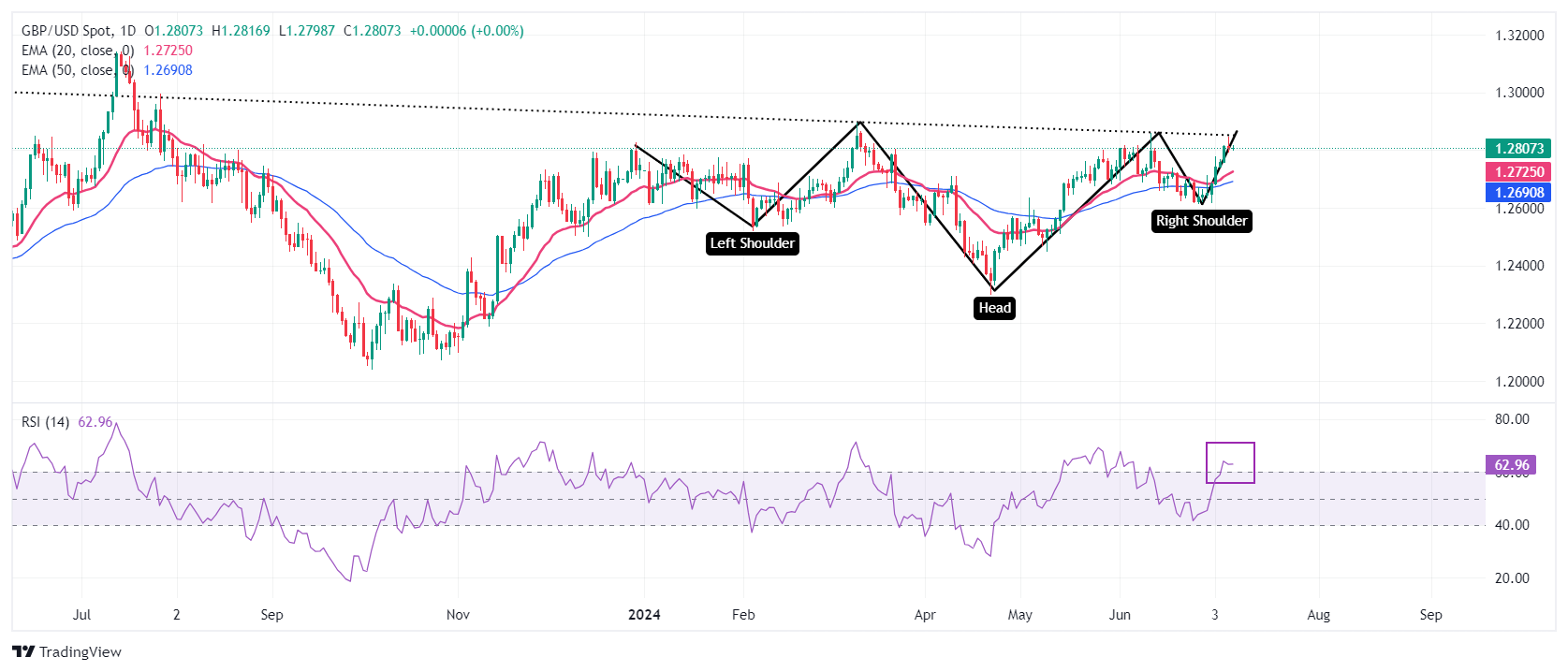- The British Pound holds gains against the US Dollar with focus on Fed’s Powell testimony.
- BoE’s Haskel argued in favour of keeping interest rates stable at their current levels.
- This week, investors will be paying close attention to US CPI data and UK factory data.
The British Pound (GBP) is holding above 1.2800 against the US Dollar (USD) in early London trading on Tuesday. The GBP/USD pair remains calm as investors await Federal Reserve (Fed) Chair Jerome Powell’s semi-annual testimony before Congress, scheduled for 14:00 GMT.
Fed’s Powell is expected to acknowledge some progress on inflation and remain data-dependent for rate cuts. Powell could continue to refrain from providing a time frame for rate cuts and emphasize the need to keep interest rates higher until policymakers see inflation declining for months. However, he could also signal some concerns about moderating strength in the US labor market.
The overall appeal of Cable is quite firm as market speculation for the Fed to start cutting interest rates as early as the September meeting has deepened. According to the CME FedWatch tool, 30-day federal funds futures price data shows that the probability of rate cuts in September has improved to 77% from 65.6% recorded a week ago. Expectations for early Fed rate cuts have been boosted by the US Non-Farm Payrolls (NFP) report for June, which indicated that the labor market has lost momentum.
This week, the main trigger for the US dollar will be the US Consumer Price Index (CPI) report for June, due out on Thursday. The US CPI report is expected to show that core inflation, which excludes volatile food and energy items, grew steadily by 0.2% and 3.4% on a monthly and annual basis, respectively. Signs of stagnation or reversal in disinflation would lower market expectations for Fed rate cuts in September, while soft numbers would raise them.
Daily Market Wrap: Sterling holds firm ahead of UK GDP data
- The British pound is posting a quiet performance against its major peers as investors focus on the UK’s monthly gross domestic product (GDP) and factory data for May, due on Thursday.
- The UK economy is estimated to have expanded by 0.2% after remaining unchanged in April. In addition, Manufacturing and Industrial Production is expected to have grown decently after contracting in April.
- On the monetary policy front, Bank of England (BoE) policymaker Jonathan Haskel advocated keeping interest rates at their current levels as price pressures in the labor market remain firm. Haskel said, “I would prefer to keep rates on hold until there is more certainty that underlying inflation pressures have declined sustainably,” Reuters reported. Haskel remains concerned about high inflation in the labor market due to strong wage growth, which is about twice as high as needed to keep price pressures in check.
- Jonathan Haskel is one of the policymakers who has voted the longest in favour of further tightening monetary policy. Contrary to Haskel’s view, traders expect the BoE to start cutting interest rates as early as the August meeting.
- On the political front, the overall outlook for the Pound has remained firm as an outright majority for the Keir Starmer-led Labour Party in the UK parliamentary elections has brought political stability to the economy.
Technical Analysis: British Pound Seeks Firm Base Above 1.2800
The British Pound is trading near a three-week high above 1.2800 in the late Asian session on Tuesday. The GBP/USD pair is forming an inverse head and shoulders chart pattern on a daily time frame. The neckline is drawn near 1.2850. A breakout of the H&S formation results in a bullish reversal.
The 20-day and 50-day exponential moving averages (EMAs) are advancing near 1.2725 and 1.2690, respectively, suggesting that the overall trend is bullish.
The 14-day Relative Strength Index (RSI) is moving up into the bullish range of 60.00-80.00. A sustained move above it will keep the momentum going higher.
The British Pound FAQs
The Pound Sterling (GBP) is the oldest currency in the world (886 AD) and the official currency of the United Kingdom. It is the fourth most traded currency unit in the world, accounting for 12% of all transactions and an average of $630 billion a day, as of 2022.
Its key currency pairs are GBP/USD, also known as the “Cable,” which accounts for 11% of the forex market, GBP/JPY, or the “Dragon” as it is known to traders (3%), and EUR/GBP (2%). The British Pound is issued by the Bank of England (BoE).
The most important factor influencing the value of the British Pound is the monetary policy decided by the Bank of England. The Bank of England bases its decisions on achieving its main objective of “price stability”, i.e. a stable inflation rate of around 2%. Its main tool for achieving this is the adjustment of interest rates.
When inflation is too high, the Bank of England tries to contain it by raising interest rates, making credit more expensive for individuals and businesses. This is generally positive for the GBP, as higher interest rates make the UK a more attractive place for global investors to park their money.
When inflation is too low, it is a sign that economic growth is slowing. In this scenario, the BoE will consider lowering interest rates to make credit cheaper, so that companies borrow more to invest in growth-generating projects.
The data released gauges the health of the economy and can influence the value of the Pound. Indicators such as GDP, manufacturing and services PMIs, and employment can influence the direction of the Pound.
A strong economy is good for the British Pound. Not only does it attract more foreign investment, but it may encourage the Bank of England to raise interest rates, which will directly strengthen the British Pound. Conversely, if economic data is weak, the British Pound is likely to fall.
Another significant indicator for the pound is the trade balance. This indicator measures the difference between what a country earns from its exports and what it spends on imports during a given period.
If a country produces highly sought-after exports, its currency will benefit exclusively from the additional demand created by foreign buyers who wish to purchase these goods. Therefore, a positive net trade balance strengthens a currency and vice versa for a negative balance.
Source: Fx Street
I am Joshua Winder, a senior-level journalist and editor at World Stock Market. I specialize in covering news related to the stock market and economic trends. With more than 8 years of experience in this field, I have become an expert in financial reporting.








